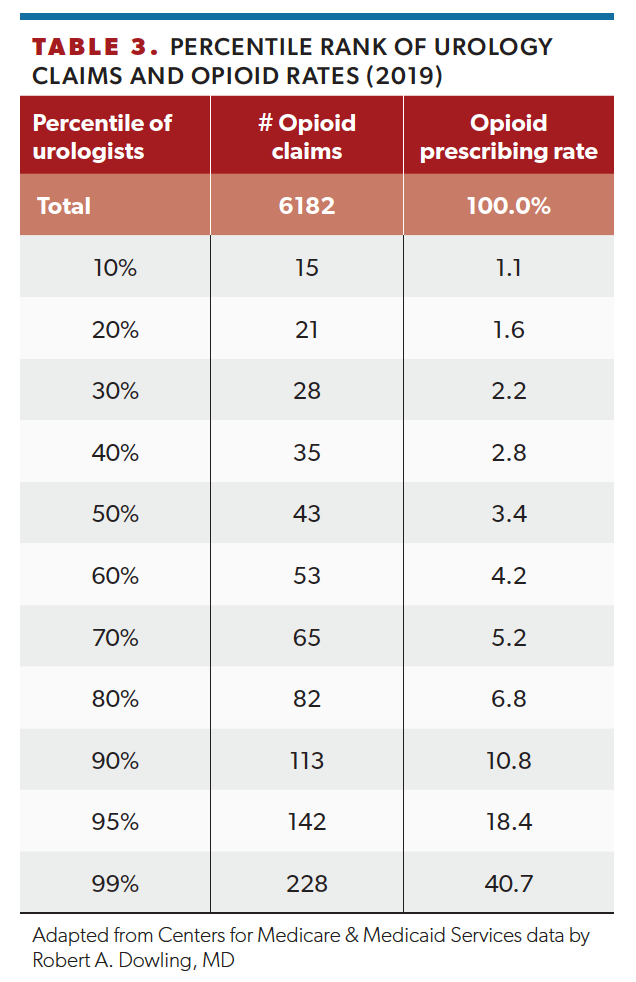Article
How often are urologists prescribing opioids?
Author(s):
Medicare Part D data reveal how urology compares with other specialties.
Robert A. Dowling, MD

One year ago, I wrote an article1 focusing on the urologist’s role as a responsible prescriber of opioids in the context of an ongoing crisis of opioid overuse, abuse, and deaths in this country. I noted that urologists—relative to other specialties—collectively prescribed opioids in 2018 in numbers and rates lower than the national average. This information comes from publicly available Medicare Part D prescription claims data, which include detailed prescriber information. In this, the first in a series of articles based on this data set, I will provide an update on the Part D prescribing habits/norms/benchmarks of urologists, beginning with an update on opioids.
Why information is more available
Several developments have led to the widespread availability of your prescribing activity. First, of course, is the widespread adoption of electronic prescribing. Large networks (ie, Surescripts) connecting electronic health record (EHR) systems, pharmacy benefit managers, retail and specialty pharmacies, and health plans generate big data based on your prescriptions. Second, legislative and regulatory activity at the state and federal levels now generally mandate electronic prescribing—increasing the completeness and value of these data sets. Third, all 50 states now have requirements to consult a statewide registry (prescription drug monitoring program) when prescribing controlled substances.
Finally, in recent years, the Centers for Medicare & Medicaid Services (CMS) has made Medicare and Medicaid spending data available at the provider level—including prescription claims. Large, multinational companies (eg, IQVIA) have aggregated your prescribing data and commercialized it to help pharmaceutical companies deploy their marketing and sales forces, guide research efforts, and develop strategic plans. These companies may know a lot more about your habits than you do.
Data on your Medicare Part D prescriptions are also available to you for free. Another good source of your prescribing data is your EHR—most have basic reporting on provider and drug. But your EHR cannot benchmark your habits to urologists outside your own practice. That is where you need a public data source.
CMS recently updated its information on prescription claims for Medicare beneficiaries enrolled in Part D (prescription drug coverage) aggregated by provider and drug to include 2019 data.2 (Approximately two-thirds of Medicare beneficiaries are enrolled in Part D drug plans.) A related data set includes summary information on opioid and antibiotic prescribing rates. These data sets suppress information on providers or drugs with 10 or fewer claims because of the small chance of identifying a patient but contain enough information to serve as good benchmarks.
A total of 1.5 billion Part D claims involving 1.24 million Medicare providers were submitted in 2019, including 65 million opioid claims (down almost 6% from 2018). The opioid prescribing rate is measured as the number of opioid claims/all Part D claims (expressed as a percentage), and averages 4.3% for all specialties. The specialties with the highest opioid prescribing rates are pain management (57%), anesthesia (53%), hand surgery (48%), physical medicine and rehabilitation (40%), and orthopedic surgery (36%). Urology ranks 82nd among specialties in overall opioid prescribing rate at 2.8% of claims. Collectively, urologists were identified with 390,982 opioid claims in 2019, down 6.4% from the previous year. The average number of Part D opioid claims/urology provider was 57, about the same as in 2018.

How do your habits compare with those of other urologists? In 2019, 6182 urologists prescribed 18 types of opioids (Table 1). The most common drugs were hydrocodone/acetaminophen (48%), oxycodone HCl/acetaminophen (22%), and tramadol HCl (14%). Most urologists (93%) prescribed only 1 or 2 opioid drug types (Table 2). To view your data, go to https://bit.ly/3tS5L86 and search for your National Provider Identifier or name, and scroll to the column marked [Opioid_Tot_Clms]. Compare your number of opioid claims with the benchmarks in Table 3. For example, if you are associated with 65 opioid claims, you prescribed more opioids than 70% of your peers in this data set. You can also compare your opioid prescribing rate with the urology benchmarks; a rate of 10% means your prescribing rate is more than 90% of urologists. Keep in mind that although Medicare beneficiaries typically account for a significant fraction of a urology practice, your prescribing habits reflected here may not be generalizable to all patients.

How do opioids contribute to the cost of prescription medicines in the Part D program? Opioids are relatively inexpensive drugs, which may contribute to the potential for abuse. The total cost for opioid claims in 2019 was
$2.8 billion, a fraction of total Part D spending. Urology opioid claims totaled only $3.2 million. There is considerable variation in cost among the class, all of which are readily available as generic drugs (Table 1).

The bottom line and why it matters
Urologists prescribe opioids to Part D beneficiaries in smaller quantities and rates than most other specialists, including surgical specialists. It has been estimated that 6% to 9% of urologic surgery patients show evidence of persistent opioid use 3 months after their surgery,3 and it is encouraging from a public health perspective that fewer opioid claims were filed in 2019 than 2018. Urologists should be aware of the small but significant risk of opioid prescription leading to persistent use or even abuse and follow specialty guidelines for counseling and prescribing.4,5 Medicare Part D data on each individual prescriber are readily available to urologists, patients, and the public and can be used to compare your prescribing habits against national and specialty benchmarks.
References
1. Dowling RA. The urologist’s role as a responsible opioid prescriber. Urology Times®. May 31, 2021. Accessed March 30, 2022. https://bit.ly/3ITBn1x
2. Medicare Part D prescribers - by provider and drug. Centers for Medicare & Medicaid Services. Updated August 31, 2021. Accessed March 30, 2022. https://bit.ly/3qO8wFE
3. Ziegelmann MJ, Findlay BL, Britton CJ, Habermann EB. Opioid prescribing after urologic surgery: we are part of the problem and part of the solution-an invited commentary on “an opioid prescription for men undergoing minor urologic surgery is associated with an increased risk of new persistent opioid use”. Transl Androl Urol. 2020;9(3):997-1000. doi:10.21037/tau-2020-05
4. AUA position statement: opioid use. American Urological Association. Updated January 2019. Accessed March 30, 2022. https://bit.ly/3uC3FHl
5. Prescription opioids: what you need to know. Centers for Disease Control and Prevention. May 9, 2016. Accessed March 30, 2022. https://bit.ly/3o1XxFU
Newsletter
Stay current with the latest urology news and practice-changing insights — sign up now for the essential updates every urologist needs.

















